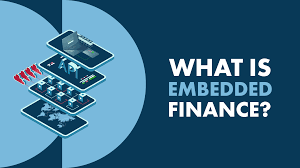The financial sector is rapidly changing due to the digitalization of almost every aspect of life, prompting new terminologies such as “what is embedded finance.” The fundamental description of embedded finance is clear, as it involves the blending or embedding of financial services in non-financial platforms. However, the concept’s surface description barely scratches its potential in redefining the financial world.
This article aims to provide a detailed picture of embedded finance to illuminate and speculate the concept’s potential benefits to traditional banking and consumer finance. Therefore, one must not miss this journey to unravel “what is embedded finance” and its revolutionary potential.
What is Embedded Finance?
What is embedded finance? Embedded finance integrates financial services into non-financial platforms and applications in an essential and practically invisible combination of financial activities with the routine usage of services. In other words, decentralizing financial services enables even more people to access and conveniently use them efficiently.
In practice, embedded finance can be embedded in various ways, such as payment processing and management in e-commerce platforms, lending and renting possibilities in mobile applications, or insurance options in booking systems. The essential feature of embedded finance is that it allows for the direct embedding of financial services in existing platforms, making the usage of financial products and services possible with no necessity to go to financial institutions.
Embedded finance is enabled by the development of technology, particularly APIs, which will allow a connection between different systems for more seamless and convenient usage. As such, embedded finance has the potential to create a more democratized approach to financial services, enabling businesses to provide more holistic solutions with the connection of different systems and changing people’s approach to money and its usage.
The Rise of Embedded Finance
The multimodal rise of several factors has contributed to the rise of embedded finance:
- The possibility of integrating financial services into our daily lives has become achievable due to the proliferation of smartphone utilization and mobile app adoption.
- The development of Application Programming Interfaces has evolved into a highly functional approach that enables secure and efficient data sharing between financial institutions and non-financial platforms.
- A rapidly growing stream of convenience and changing consumer habits towards on-demand services have fostered the development of embedded finance solutions.
Benefits For Businesses and Consumers
What is embedded finance? Embedded finance is a game-changer for businesses and consumers who can leverage its advantages to receive unprecedented value across the value chain. From a business perspective, integrated financial solutions enable higher consumer satisfaction with the services delivered, directly resulting in increased monetization opportunities through traditional and alternative payment methods.
The performance of financial activity within the existing platforms also benefits organizations by enabling them to monetize payment processing with the help of fees from transactions conducted with financial partners, as well as creating additional sources of revenue through core products with new partners.
Moreover, the streamlined financial processes translate to business cost savings and increased operational performance. For consumers, embedded finance is associated with unparalleled convenience as users do not need to visit banks or switch between multiple applications; instead, they access the embedded financial operations and execute them in-app non-financial native, creating an improved experience.
Consumers also benefit from enhanced personalization and customization, choosing the most relevant solutions. More importantly, embedded finance drives financial inclusion by making banking equally accessible for all, improving the range of service delivery.
Examples Of Embedded Finance
What is embedded finance? Embedded finance is a new concept that describes the amalgamation of financial services with non-financial platforms. Embedded finance has increased in several industries for the past decade. A notable example of embedded finance is the Buy, Now, Pay Later service trend facilitated by companies like Klarna and Afterpay.
These services allow users to access credit options by financing their purchases just as they check out at the store while still on the online shopping platforms. Similarly, platforms offering ride-sharing services like Uber and Lift have utilized this embedded finance feature, and they have payment processing capabilities that eliminate the hustle of paying cash for rides.
Investment platforms are building in robo-advisory services, making investments even more accessible to people. Individuals are not locked out of investment if they don’t know much about the computer programs for you and don’t even recommend how to invest your money. The wide range of platforms adopting this technology shows that a great innovation with exceptional power can transform the buying experience and access to financial services.
Challenges And Opportunities
However, embedded finance has challenges and threats, especially regarding data privacy and security. Indeed, the closer integration of financial services with various platforms implies maintaining high levels of cybersecurity to prevent sensitive financial data breaches. In this connection, companies engaging in embedded financing should also ensure compliance with numerous legal regulations.
Moreover, the loose line between business sectors implies regulatory difficulties and conflicts of interest. Nevertheless, these risks are accompanied by multiple opportunities. Thus, embedded finance enables new revenue streams from platforms that might monetize their operations by utilizing financial services and improving customer experience. Furthermore, data analytics combined with artificial intelligence helps companies offer customers personalized financial products on presentation.
Conclusion
What is embedded finance? Embedded finance is a game-changing approach to viewing and using financial services. Integrating financial features and processes into conventional nonfinancial items and services allows people to enjoy more comfort and user-friendliness. It enables financial services to be used directly in people’s lifestyles, much to their delight.
This increases the quality of services offered and opens up new paths to growth by reducing the complexity of regularly buying items and services. In this environment where technology continues to evolve, having a comprehensive understanding of what embedded finance does is vital. Embedded finance is a giant leap forward in the relationship between finance and other industries. What is embedded finance has the potential to transform life for the better.

